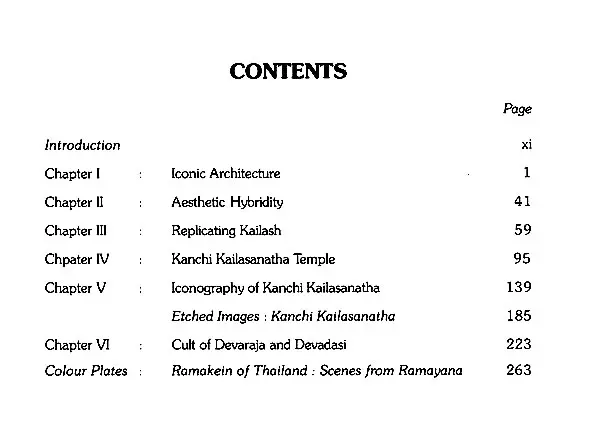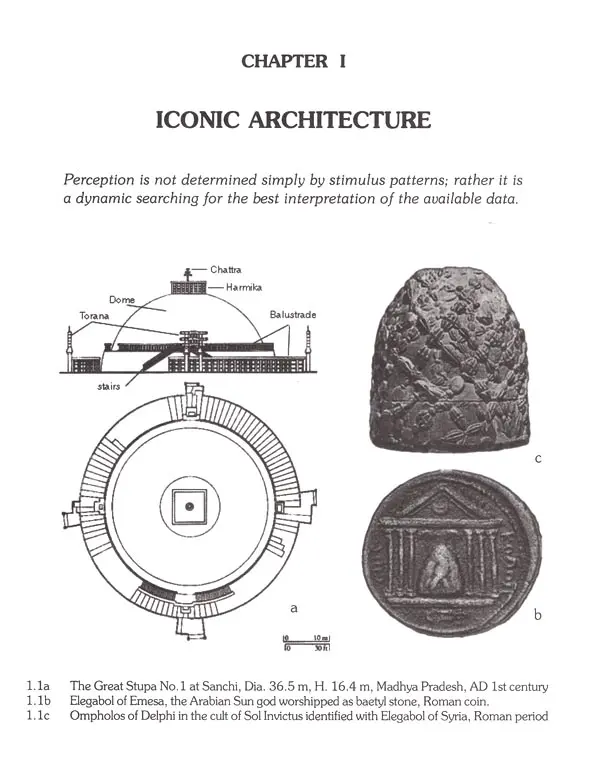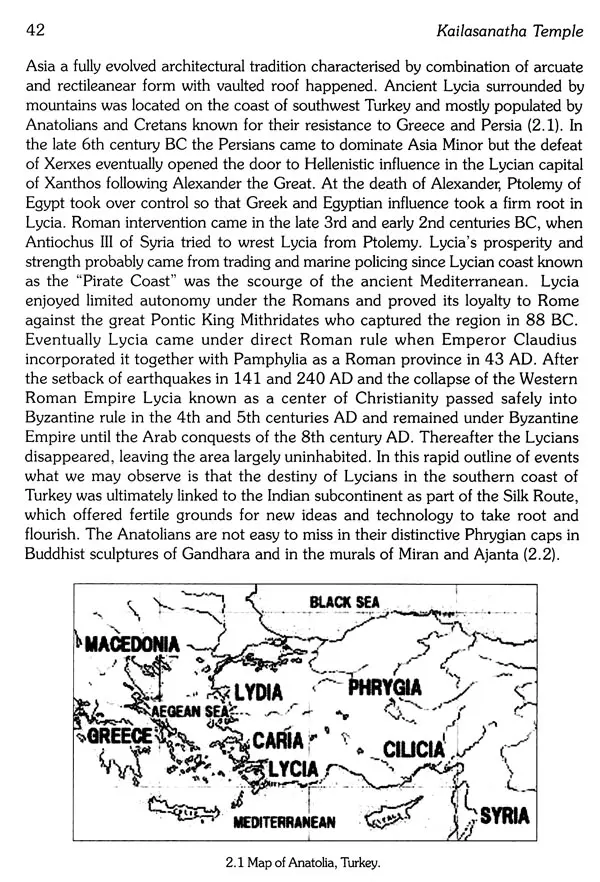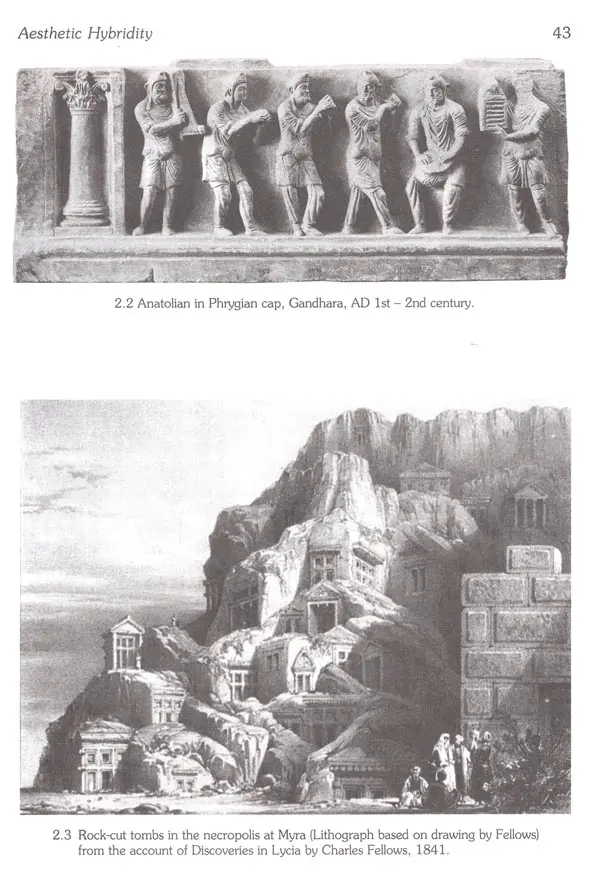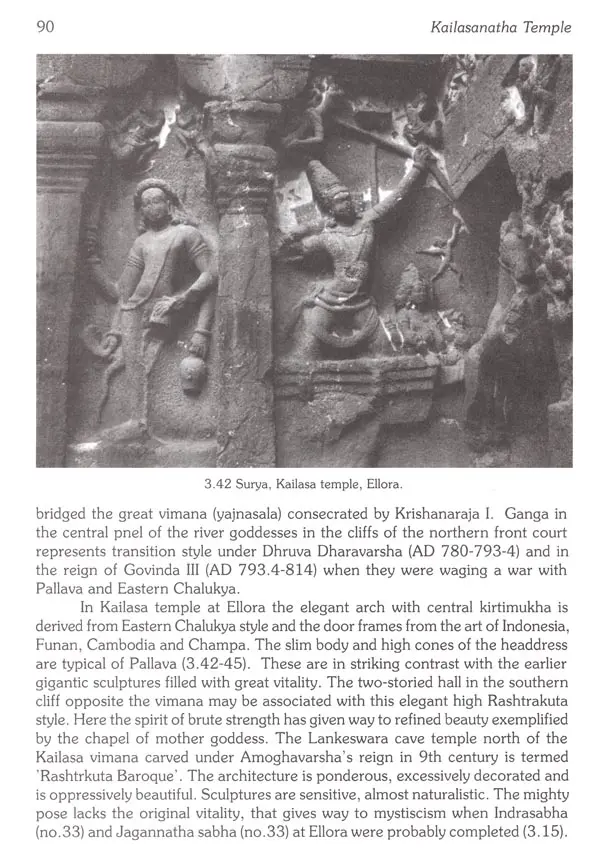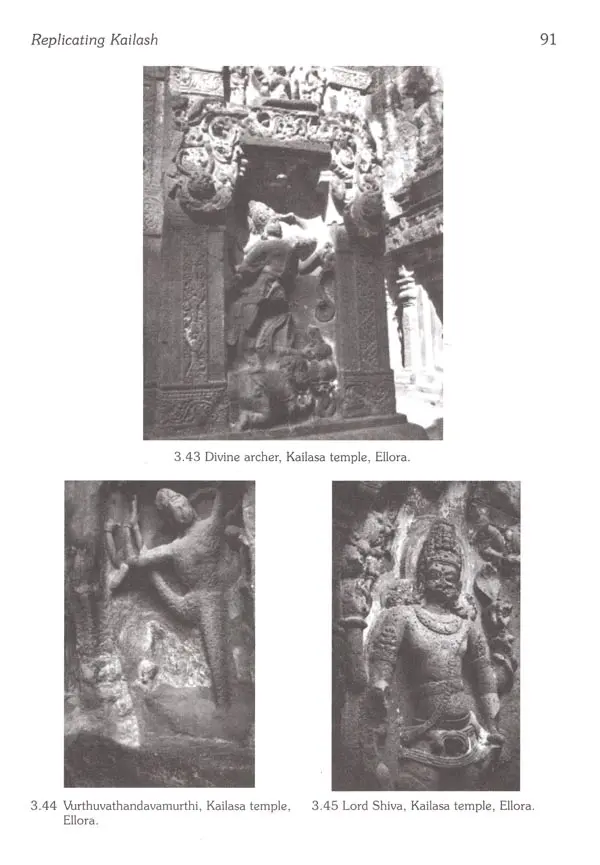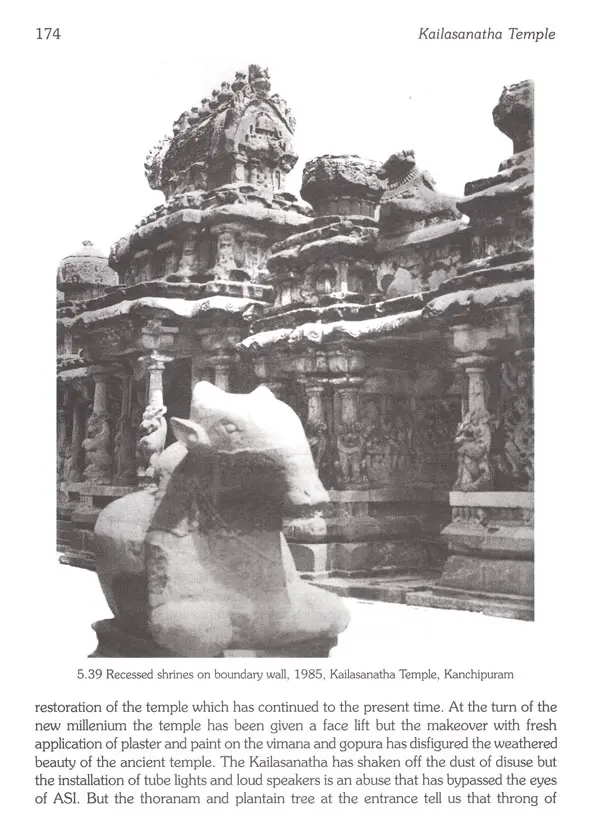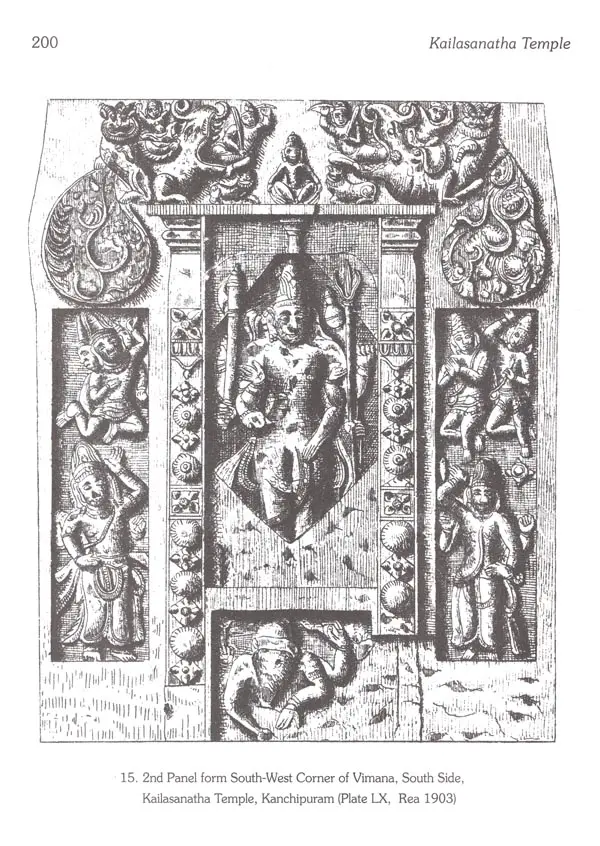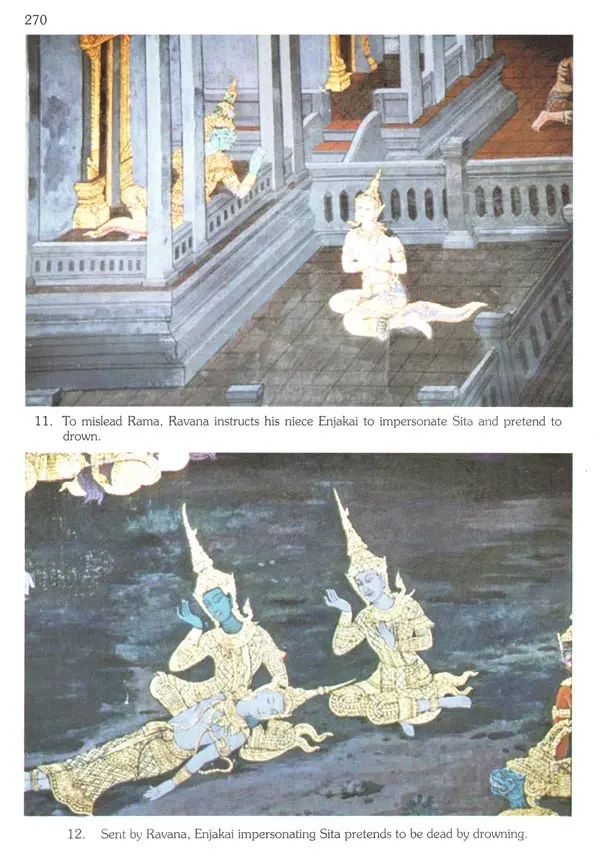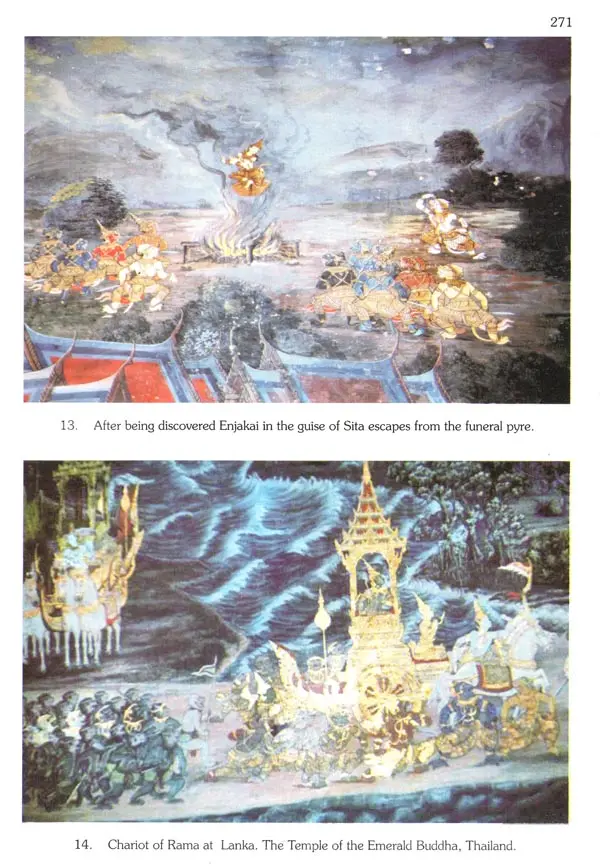
Kailasanatha Temple- The Realm of Immortals
Book Specification
| Item Code: | UAN325 |
| Author: | ArputhaRani Sengupta |
| Publisher: | Agam Kala Prakashan, Delhi |
| Language: | English |
| Edition: | 2009 |
| ISBN: | 9788173200885 |
| Pages: | 286 (Throughout Color and B/w Illustrations) |
| Cover: | HARDCOVER |
| Other Details | 11.00 X 9.00 inch |
| Weight | 1.05 kg |
Book Description
This new cultural study looks at the intersection of Hellenistic and Egyptian Lycian art forms in the religious sphere of dynastic India that was ushered by Buddhist Cult during the early Christian era. While specifying uniqueness of Indian culture it looks for external parallels and attempts to define the archaeological and cultural affiliation observed in terms of history of art forms in their cultural context. A discussion of artistic change, cultural identity, and religious belief foregrounds the most important monuments that typify the concept of Kailasa, abode of gods on the sacred peak of Himalayan Mountain. The 8th century Kailasanatha Temple at Ellora in the Deccan and at Kanchipuram in South India are both architectural marvels defining the Dravidian style, one is a sculptured monolith and the other earliest structural temple. Both are modeled after rock cut Dharmaraja Ratha at Mahabalipuram at tangent with the Gupta temple in North India, which set the stage for fundamental change in the design of religious monument that never the less derives its form from Buddhist art and architecture.
ArputhaRani Sengupta is Professor in History of Art at the National Museum Institute (Deemed University), New Delhi, India. She specialises in ancient art of Egypt, Mesopotamia and the Buddhist art of India synchronal to the Roman Empire. In her writings the study of signs and symbols in material culture as a system of visual communication is devoted to the reciprocal knowledge in an aesthetic object and its connectedness to at collective consciousness. Her research publications are on cult and cultural synthesis in the Art of Terracotta and Jewellery from Buddha Zone, a prelude to Buddhist Art: Symbols and Substitutes. Edited volumes with contributory essays include Cult of the Goddess in Indian Art and Culture, a sequel to God & King: Devaraja Cult in South Asian Art and Architecture. She examines pictorial semiotics with wide range of meaning in her essays such as "Cultural Synthesis in the Buddhist Art of China" (IGNCA1998), "Naqada Traced in Indus Valley Culture" (ICOM-CC2007) and "In Search of Simurgh" (BHU2009). Her primary concern is to study the ways in which transcultural non-linguistic phenomena connected to art history can generate meaning and provide information on the role of culture in knowledge production.
Born in Madurai, Tamil Nadu, ArputhaRani studied History of Fine Arts at Stella Maris College in the University of Madras and received her Doctoral degree from Rabindra Bharati University. Kolkata, India. Teaching experience prior to her present position include a period at Stella Maris College at Chennai in South India and at Teachers' Training College and College of Technology in Nigeria.
The eighth century Kallasanatha temple in Kanchipuram built by the Pallava king Rajasimha is the first structural temple that established the tenor of Dravidian style of architecture in South India. Its form is derived from a group of rock-cut Ratha' in Mamallapuram on the seashore just few kilometers from Chennai in Tamil Nadu. The monolithic Kailasa temple at Ellora (Cave 16) in Maharashtra is the dynastic temple of the Rashtrakuta that explores the history-making intersection between carving in" and "carving out" an architectural space from a living rock that results in a colossal piece of sculpture. Reminiscent of the Pallava rock-cut shrines in Mamallapuram, the Kailasa temple at Ellora is the epitome of rock-cut architecture in India and unique in its scope and size. Ellora is UNESCO World Heritage Site. The Rashtrakuta king Dantidurga who locked horns with Lalitaditya and then forged a matrimonial alliance with him leads us on to Martanda temple of the eighth century built by Lalitaditya in the Himalyan valley of Kashmir. It is one of the earliest and yet largest stone temples to have been built in Kashmir. Thus from Kanchipuram to we have three great temples of the eighth century that aspire to replicate Mount Kailash (Kailasa Parvata) the abode of Shiva as the ultimate spiritual journey anchoring us to the cultural dynamics of the period. At the core of Hindu faith is Shiva on the summit of Mount Kailash residing with his wife Parvathi in perpetual bliss. Kailash in the north is described as the center of the world and Shiva's lingam or the pillar that corresponds to the Greek Omphalos, the navel of the Universe (1.1b). Ultimately Kailash is paradise on Earth, its slopes paved with jewels, gold and lapis lazuli.
The great temples are major turning point in the life of a king who exercised his prerogative to sculpt and build them. The temples soaring to the sky like Mount Kailash could be understood as metaphors for psychological transformations. The lion and the elephant dominate the iconography of the Kallsanatha temple in both Kanchipuram and Ellora. The lion is symbol of the sun as well as the supreme ruler on the earth and when combined with the elephant as Gajasimha assumes a new meaning derived from the iconography of Gajalakshmi who is the King's consort Rajyasri. The elephant inseperable from the lion is a symbol for spiritual nature that serves as a vehicle for entrance into the sacred realm of the immortals. At Ellora the immovable rock-cut temple Kailasa is metaphorically lifted off the ground by rows of elephants ranged at various levels. And on the roof of mandapa the lions oriented towards cardinal points reach a climax in an embrace with the elephant on the vimana crowned by the kalasa of Srilakshmi. At every turn and every angle symbolic message is carved from the base to the crown of the sculptured temples with an extraordinary revelation of meaning that could be found in very direction and at each level. Certainly ritual as mythic experience dominated the three great temples built as a metaphor for Mount Kailash. We can at best appraise and appreciate the iconography from Kanchi to Kashmir revealing the mythscape of the Hindu psyche.

